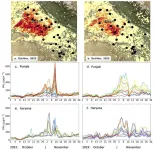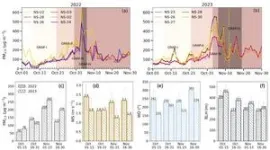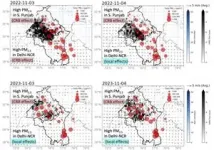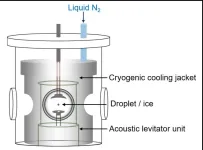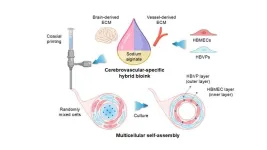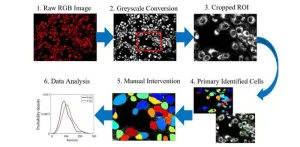International collaborative research led by Aakash Project* researchers at the Research Institute for Humanity and Nature (RIHN) show an unequivocal contribution of crop residue burning (CRB) to air pollution in the rural/semi-urban regions of Punjab and Haryana, and a relatively lower contribution than previously thought to the Delhi national capital region (NCR). We have installed 30 units of compact and useful PM2.5** in situ instrument with gas sensors (CUPI-Gs) and have continuously recorded air pollutants in 2022 and 2023. New analytical methods have been developed to assess and predict the formation and transport of air pollutants due to emissions from CRB.
The adverse impacts of air pollution on human health, economic activities and lifestyle have been a major concern for decades as pollution at an alert level occurs each year during the October-November months in Delhi-NCR. One of the many hypotheses, to explain rapidly built-up and sustained high PM2.5 concentrations in Delhi-NCR, implicates large contributions from the paddy CRB in Punjab and Haryana states of northwest India (Fig. 1). Burning of rice stubbles in the region is a common practice for land clearing since mechanised paddy harvesting is adopted and is thought to protect fields from pests and preserve soil fertility. Although this formation mechanism of air pollution in Delhi-NCR is debated till date (e.g., in media reports and research publications), policymakers at state and central government levels have targeted eradication of CRB by changing behaviour of farmers in land clearing. The debate continues mainly because of the lack of systematic measurements from the regions of concern. In this study, the research team used a combination of (1) measurements from the Aakash Project’s low cost CUPI-G network, (2) analyses of air mass trajectories, fire counts and wind patterns, and (3) chemistry-transport simulations to assess the impact of CRB on PM2.5 in rural, sub-urban and megacity regions.
The research findings highlight that, despite a significant reduction in the satellite fire detection counts (FDCs) over Punjab and Haryana from 2015 to 2023, PM2.5 concentrations in Delhi have remained high. The PM2.5 concentrations showed large day-to-day fluctuation from site-to-site in both 2022 and 2023 (Fig. 1). Both years saw significant fire counts in southwest Punjab with daily-mean PM2.5 exceeding 300 μg m–3 in Delhi, but the meteorological conditions were markedly different for the peak CRB days of November 1st – 12th of 2022 and 2023. November 2022 witnessed a prevalence of northwesterly winds allowing the transport of airmass from Punjab and Haryana to Delhi-NCR on two occasions. However, in November 2023, a southwesterly low wind condition with speed <1 m s–1 limited air movement causing an accumulation of local pollutants in Delhi-NCR (Fig. 2). Our analyses showed that the buildup and sustenance of PM2.5 in the Delhi-NCR is primarily of local origin and can be inferred from the rise/drop in concert with implementation/revocation of Graded Response Action Plan (GRAP) stages as administered by the Commission of air quality management (CAQM) (Fig. 2).
“With the measurements at a network of about 30 sites covering Punjab, Haryana and Delhi NCR, we are able to separate the contributions of paddy straw burning to Delhi’s PM2.5 variations on the basis of characteristic PM2.5 events and at week-monthly averages,” says Prof. Prabir Patra, the leader of Aakash Project and principal scientist at Japan Agency for Marine-Earth Science and Technology (JAMSTEC). Multiple years of data (2022-2023; now 2024) gathered by the project helps to confirm the findings and (in)validate the hypothesis (Fig. 3).
Based on several types of analysis as presented in Mangaraj et al. (2025), we have been successful in processing the observation data and model-based analysis in near real-time. These data and plots have been shared online daily via the Aakash-RIHN website since 2023 (e.g., https://aakash-rihn.org/en/campaign2023-week13/). We have concluded that CRB in Punjab and Haryana cannot be made responsible for determining the air quality in Delhi-NCR, even during the peak rice stubble burning period (Oct-Nov). Apart from the fact that the horizontal wind flow is blocked by the Himalayas to the north (ref. Fig. 1a, c), the freshly emitted and photo-chemically formed PM2.5 is randomly transported in the other 3 directions horizontally and is diluted vertically through the planetary boundary layer ventilation (Fig. 3). “Our study underscores the importance of continuous monitoring of air pollutions in both source (Punjab), receptor (Delhi-NCR) and intermediate (Haryana) regions for implementation of targeted mitigation strategies to combat persistency of harmful air pollution,” says Dr. Poonam Mangaraj, the lead author of the article.
This research is conducted as part of the Aakash Project * (Project No. 14200133) of RIHN, a constituent member of NIHU. The intensive field campaigns of 2022-23 was conducted with support from the Centers for International Projects Trust (CIPT), India.
The measurement data of PM2.5 are made available from the RIHN database with open data sharing policy (https://aakash-rihn.org/en/data-set/).
*The Aakash project is exploring ways to shift people's behaviour to sustainable agriculture in the Punjab region to reduce the health hazards caused by air pollution, by clarifying observation-based relationship between straw burning and local air pollution; raising awareness of the importance of maintaining clean air among residents; and proposing the effective and beneficial use of rice straw by farmers.
**PM2.5: particulate matter less than 2.5 µm in diameter (popularly known as PM2.5). These fine particles can be inhaled during human breathing. Depending on chemical composition, defined by oxidative potential (OP), they damage the pulmonary cells. The particulates from materials burning usually have greater OP than those from natural sources, e.g., mineral dusts or secondary organics.
Article information
Title: Weak coupling of observed surface PM2.5 in Delhi-NCR with rice crop residue burning in Punjab and Haryana
Journal:npj Climate and Atmospheric Science
Authors: Poonam Mangaraj, Yutaka Matsumi, Tomoki Nakayama, Akash Biswal, Kazuyo Yamaji, Hikaru Araki, Natsuko Yasutomi, Masayuki Takigawa, Prabir K. Patra, Sachiko Hayashida, Akanksha Sharma, A. P. Dimri, Surendra K. Dhaka, Manpreet S. Bhatti, Mizuo Kajino, Sahil Mor, Ravindra Khaiwal, Sanjeev Bhardwaj, Vimal J. Vazhathara, Ravi K. Kunchala, Tuhin K. Mandal, Prakhar Misra, Tanbir Singh, Kamal Vatta, and Suman Mor
Article Publication Date: January 15, 2025
URL: https://doi.org/10.1038/s41612-025-00901-8
###
About RIHN
The Research Institute for Humanity and Nature (RIHN) is a national institute established in Kyoto in 2001. RIHN aims, through research that integrates the humanities and sciences, to address environmental issues concerning the relationship between "humanity" and "nature" in a broad sense as fundamental issues of human culture. We strive not only to engage the research community but also to collaborate with diverse stakeholders in society, including local residents, to find solutions to global environmental problems.
For more detail, visit https://www.chikyu.ac.jp/rihn_e/.
END
